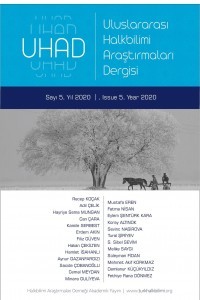
On dokuzuncu yüzyıl, âşık edebiyatının zirve yaptığı bir yüzyıl olmuştur. On yedinci yüzyılda olduğu gibi bu yüzyılda da güçlü âşıklar, saz şâirleri yetişmiştir. Bu yüzyılın âşıklarının temel özelliği, az çok medrese tahsili görmeleri ve klasik edebiyattan etkilenmeleridir. Ayrıca bu yüzyılda İstanbul, âşıkların buluşma noktası olmuştur. İkbal için İstanbul’a gelen âşıklar, sanatının kuvveti ölçüsünde orada barınabilmiş ya da oradan ayrılmak zorunda kalmıştır. Sanat kabiliyeti yüksek olan âşık ve saz şairleri zaman zaman sarayda da bulunmuşlardır. Erzurumlu Emrah’ın çıraklarından Tokatlı Nuri’ye çırak olan Âşık Ceyhûnî, 19.yüzyılda yaşamış bir halk şairidir. Kaynaklarda üç tane Ceyhûnî’den söz edilmektedir. Bunlar, Karslı, Erzurumlu ve Zileli Ceyhûnî’dir. Karslı ve Erzurumlu Ceyhûnî hakkındaki bilgiler çok azdır. Yapılan çalışmalar daha ziyade Zileli Ceyhûnî üzerinedir. Biz bu çalışmamızda kısaca bütün Ceyhûnîler üzerinde durduk. Elimizdeki bir mecmuadan hareketle Ceyhûnî hakkında yeni bilgiler elde ettik. Kastamonulu Âşık Fevzi (1857-1917)’ye ait Fusûl-ı Âşıkân adlı şiir mecmuasında bulunan yedi adet Ceyhûnî mahlaslı şiiri inceledik. Şiirlerin üç tanesinin üzerinde yazan bilgiden hareketle bu şiirlerin Bitlisli Ceyhûnî adlı başka bir şâire ait olduğunu tartıştık.
The nineteenth century was a century when minstrel literature peaked. As in the seventeenth century, strong minstrels and folk poets were raised in this century as well. The main feature of the folk poets of this century is that they had more or less education in madrasahs and were influenced by classical literature. Also, in this century, Istanbul has been the meeting point of folk poets. The minstrels who came to Istanbul for their prosperity either were able to stay there or had to leave there depending on the strength and quality of their art. Minstrel and folk poets with high artistic skills were also in the palace from time to time. Âşık Ceyhûnî, who was an apprentice to Nuri of Tokat, one of the apprentices of Emrah from Erzurum, is a folk poet who lived in the 19th century. There are three Ceyhûnî 's mentioned in the sources. These are Ceyhûnî from Kars, from Erzurum and from Zile (Tokat). There is very little information about Ceyhûnî from Kars and Erzurum. Studies are mostly on Ceyhûnî from Zile (Tokat). In this study, all Ceyhunis will be briefly focused on. New information about Ceyhûnî is obtained and presented based on a poetry magazine. Seven poems with the pen name of Ceyhûnî in the poetry magazine named Fusûl-ı Âşıkân, which belongs to Âşık Fevzi (1857-1917) from Kastamonu were examined. Based on the information written on three of the poems, it was found out and discussed that these poems belong to another poet named Ceyhûnî from Bitlis.

| Relevant Articles | Author | # |
|---|
| Article | Author | # |
|---|